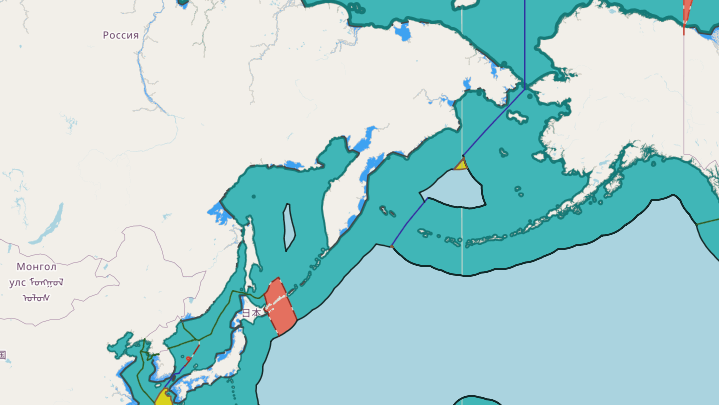pursuant to article 76, paragraph 9, of the Convention of a chart permanently describing the area of the continental shelf beyond 200 nautical miles in the region of the Sea of Okhotsk.

Sea of Okhotsk
In 2014, the UN Commission on the borders of the Continental Shelf adopted a positive decision on the Russian application for expansion of the borders of Russia’s continental shelf in the Okhotsk Sea. As a result of this decision, the central part of the Okhotsk Sea (52,000 sq. km.) was included in the RF Continental shelf (Reccomendations of the CLCS, 2014).
Comments from the Russian side, including from Russian officials, contain the statement that since the approval of the Russian application by the Commission, the Sea of Okhotsk has become a Russian Inland Sea (Zykova, 2014).
Such statements, however, are untrue because of Russia’s existing limit of a 200-mile EEZ in the Okhotsk Sea. Russian sovereignty over the central part of the Okhotsk Sea shelf does not apply, to include the water and bioresources that are contained in therein (shrimp, shellfish, crabs, etc.) (Art. 78, UNCLOS). The legal regime of fisheries for both Russian vessels and those of other nations in the central zone is not altered by a decision of the Commission, but the aspects of cooperation between offshore energy and fishing companies that have economic interests in this part of the sea are subject to clarification.
Maritime policy of Russia in the Far East and territorial dispute between Russia and Japan
In the Far East, the most problematic maritime issues for the Russian Federation are with Japan. The two States have a long history of maritime relations, the core problem of which was and remains the territorial identity of the islands of the Kuril Archipelago. In addition to this matter, other interesting examples of Russian maritime policy that can be seen in the Japanese and Okhotsk Seas are the issues of shelf and legal regimes; the use of water resources of the Okhotsk Sea and the desire of Russia to declare the Gulf of Peter the Great a territorial sea.
Russia claims to the waters of theGulf of Peter the Greatin the Sea of Japan as a proper territorial sea, the boundaries of which are defined by direct rising lines from the extreme points of the bay. Japan, France, UK, and the USA do not agree with this position. Moscow’s reasoning is built mainly on the fact that this bay is the “historical gulf” of the Russian Federation, respectively, its status is regulated by the Convention on the Territorial Sea and the Contiguous Zone, and the boundaries of Russian sovereignty are determined by UNCLOS article 7 and article 10 paragraph 6.
For Reference: In 1957, the USSR announced the Gulf of Peter Great as its inland waters. U.S., Japan, France, and Britain refused to acknowledge this decision on the grounds that the width of the entrance to the Bay of 102 miles, which considerably exceeds the limit of 24 milesset by UNCLOS. Moscow, in response, stated that the Gulf of Peter the Great belongs to the category of “historical bays,” which was defined by Russia in 1901 in the rules of maritime fisheries in the territorial waters of the Amur Governor-General, as well as in the contracts with Japan on Fisheries 1907, 1928 and 1944.

